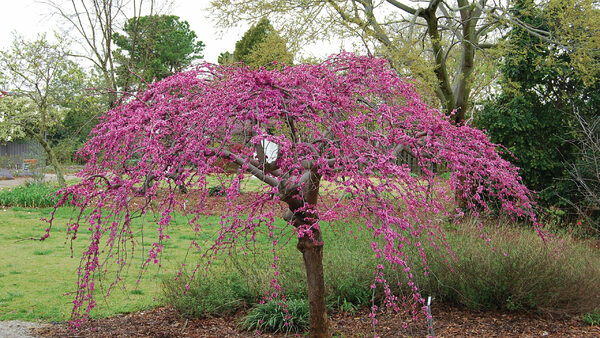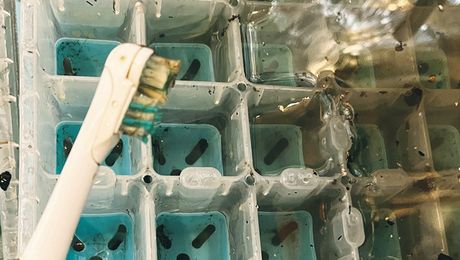
With apologies to Shakespeare and Hamlet, to stake or not to stake is the question. When it comes to staking trees, too many gardeners choose the former option. It is true that there are situations when a young tree is thankful for some mechanical aid, but not as often as many gardeners imagine. Furthermore, even when staking is beneficial to a newly planted tree, it usually remains so for only a short period of time.
Staking a tree that does not need it can do more harm than good. Movement of the trunk helps strengthen it by thickening it and giving it taper from bottom to top. Trunk movement also stimulates root growth. So although staked trees might grow taller faster than their unstaked counterparts, their trunks are weaker and their root systems are less developed.
When done incorrectly, staking further compounds a young tree’s problems. If a tree is tied to a stake too tightly, girdling can occur, weakening and even possibly killing the tree unless the problem is addressed in time. Movement of a tree above where it is tied too tightly to a stake, like movement of an unstaked trunk, results in a thicker trunk above the tie. This difference in thickness upsets smooth travel of water and nutrients up and down the developing trunk. Too tight a tie coupled with too rigid a stake can anchor a plant so firmly below the tie that a strong wind can actually blow off the top of the tree. Tying a tree too loosely to a stake also causes problems. The bark is continuously rubbed, resulting in wounds that may never heal properly.

Should you stake this tree? The root ball is small in proportion to the height of the tree and won’t be able to provide adequate support. The author points to the height the tree should be for a root ball of this size. So, yes, you should stake this one.
Crowbar Hole

The top of a trunk needs to move, but if the bottom moves too much, it can form a “crowbar hole,” where water and moisture can collect and possibly cause rot. A stake can prevent this movement.
Stakes allow a root ball to become a root system

A bicycle tire inner tube is tied to the tree in a figure-eight loop. It provides firm but flexible support.
Sometimes, however, a tree does benefit from staking. A young tree with a dense crown of leaves combined with a disproportionately small root ball is almost certain to require a stake. By staking a tree like this, its root ball will be held motionless in the soil. This temporary, artificial stability allows the roots to grow into the surrounding soil, thereby anchoring the tree and giving it a more permanent, natural stability.
Stiff winds coursing through a dense crown of leaves can also spell trouble root ball to rock back and forth instead of remaining stationary, the winds prevent developing roots from taking hold. This excessive movement could lead to a “crowbar hole,” a gap that develops around the base of a tree where water collects, potentially causing root rot. To determine if a newly planted tree’s roots are moving, I grab the trunk and move it back and forth, watching for shifting soil at the base of the tree. If I see movement, I know there’s a problem that staking can address. A stake will help to hold the trunk in place long enough for it to develop sufficient thickness and taper to thwart such movement. In the weeks and months following the planting of any tree, I frequently inspect the ground where the trunk emerges to see if a crowbar hole is developing.
Staking a tree can also offer protection. A lawn mower can be kept from continually banging a trunk and abrading its bark by some strategically placed stakes. Of course, if you have circled your tree with wood chips or any other type of mulch, you won’t need to mow near the tree. If you have planted a tree sensitive to soil compaction—sugar maple or white oak, for example—a ring of mulch or stakes signals “don’t tread here.” For protection, a trunk needs at least three stakes circling it.
A well-staked tree should be able to move in place

Photo/Illustration: Erika marks
Support for any young tree should let the top of the tree move freely and allow for some movement of the trunk, all without causing abrasion where the tie makes contact. A tie placed too high (more than two-thirds of the way up the trunk) will not allow sufficient movement of the top of the tree. To let the lower part of the trunk move adequately, use only one tie per stake.
An elastic material, such as the inner tube of a bicycle tire, is best for a tie because it allows movement at and below the point of attachment, while keeping a firm enough grip on the trunk to avoid abrasion. Other satisfactory tying materials include elastic webbing and nylon stockings. To keep the trunk from rubbing against the stake, it is best to tie any of these materials in a figure eight loop between the trunk and the stake. The common practice of using wire padded with a length of garden hose is less satisfactory for tying because it cannot grip the trunk firmly without eventually girdling it.
Good materials for the stakes themselves are lengths of metal rebar, wooden posts, and metal pipes. I’ve also staked small trees with fiberglass posts sold for use with electric fencing, which have the added advantage of being flexible themselves. Stakes should be strong enough to provide whatever support is needed but should never be so large or be placed in such a way that a tree’s trunk is too shaded. Otherwise the trunk will naturally bend away from the stake.
A single stake may suffice for a small tree whose trunk is less than a couple of inches in diameter. For a larger tree, up to 4 inches in diameter, use two or three stakes, tying each one separately to the trunk.
Stakes should be temporary, the more so the better
Even when staking is necessary, the sooner the stakes are removed, the sooner the plant can develop a strong trunk and root system. With most small trees, I remove stakes after one year; larger trees might require stakes left in place for two years. You can test to see if a stake can be removed by moving the trunk of the tree and watching for movement of the root ball. No movement means you no longer need the stake. There are exceptions: Certain dwarf apple trees, for example, require staking throughout their life. Still, for most trees, a major hazard of staking is forgetting about it, letting ties perhaps girdle a trunk, or just leaving the stakes in place so long that development of a sturdy trunk is delayed.


















Comments
In Australia we now recommend using 2 stakes, one either side of the root ball, with a figure 8 loop of stocking/jute webbing between them, rather than only one stake. It allows for some controlled trunk movement without holding it too tightly and also prevents people putting a large stake close to the trunk and right through the rootball.
To stake or not to stake, good article. It generates food for thought. I have recently provided a support system other than stakes for my large number of super high and extremely high density olive cultivars (closely planted). Actually it was by coincidence that I tie baling twine across the cultivar line in order to prevent agri-machines from inadvertently driving across my cultivars. Soon after installing the baling twine as a caution tape I became apparent that the twine was providing the young cultivar a support system without any mechanical attachment. Because I have financed the olive cultivars farming on my earnings strictly from my wages, expense is critical. Currently, I was about to buy stakes for a very large number of just planted cultivars when reading you article turned on the light and reminded me how well the twine & t-posts had in the past provide the support you advocate. Thanks for you ideas, now I will go ahead with the twine idea and time use surveyor's flagging and a stapler to provide a little mechanical attachment to the baling twine. Keep in mind you can pull real hard on baling twine to take out some of the sag. David of Imperial Valley
I have been using the Tree-Mate-O supports for the past few years and love them. They allow the trees to move slightly, encouraging root development while giving the gree plenty of support in high winds, etc. The manufacturers website is treesupports.com
Log in or create an account to post a comment.
Sign up Log in